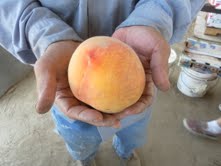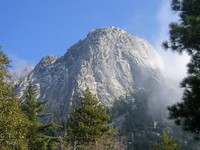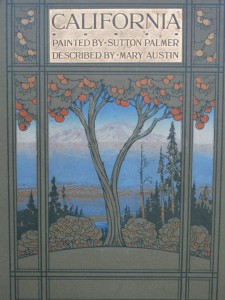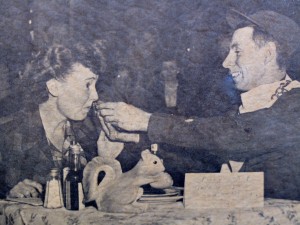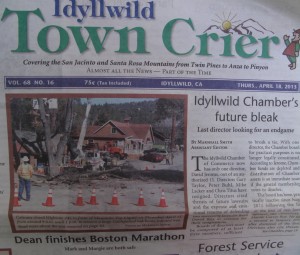NB: Reprinted (so to speak) from the Summer 2013 Eden, the quarterly journal of California Garden and Landscape History Society, www.cglhs.org. Photo: Staci Valentine, from: David Mas Masumoto, Marcy Masumoto, and Nikiko Masumoto, The Perfect Peach: Recipes and Stories from the Masumoto Family Farm (10 Speed Press, 2013)
Bearing Fruit: David Mas Masumoto
Do you dare eat a peach?
Yes, yes. Especially if it’s from the Masumoto Family Farm,
If such a luscious fruit is not at hand, well, then, don’t despair. The pleasures of mind and palate (can you imagine one without the other?) await when you pick up a book by David Mas Masumoto, the organic peach farmer who plows his stories on eighty hard-worked acres in Del Rey, California.
The Masumoto Family Farm in the San Joaquin Valley was founded by Mas Masumoto’s grandfather after World War II, when the family was liberated from its internment camp in Arizona.
The San Joaquin Valley was a very different place then.
In April the writer Verlyn Klinkenborg, a member of the editorial board of the New York Times, drove Interstate 5 through this valley but couldn’t see the Masumoto Family Farm or any of the other farms on the intimate Masumoto scale, as they are east of this mighty freeway. What Klinkenborg did see: “Every human imperfection linked to the word ‘farming’ has been erased. The rows are machined. The earth is molded . . . This is no longer soil. It is infrastructure . . . The vast regiments of nut and fruit trees . . . seem to defy the word ‘orchard’ . . . The entire valley has sunk in on itself over the years as the aquifer beneath it has been siphoned off.”
No wonder that Mas Masumoto titled his 2009 book (the first was Epitaph for a Peach, HarperSanFrancisco, 1995) Wisdom of the Last Farmer. He often feels he will be the last, and not only the last on his few acres.
The three Masumoto books I have read for this review are about the same “things” that life and work on eighty acres brings forth: trees, vines, weeds, tractors, shovels, storms, heat, cold, water, frost, sweat, dust, physical pain, labor, laborers, sunlight, starlight, soil, junk, plows, wildflowers, manure, mud, pruners, pruning, pests, perfectly timed harvests, plummeting prices, fruit brokers, the produce aisles, the lifelong search for the perfect peach.
Ten minutes of hail: destruction of the year’s labor.
Twenty-pound box of peaches: Worth two dollars in 1961; worth two dollars in 2001.
So what would you do?
The Masumoto books are also about the other “things” that bear fruit on the farm: hope, luck, family, love, risk, faith, pleasure, awareness, gratitude, fear, the exquisite calibration of the five senses, and, most of all, intimacy. Intimacy with the physical world, intimacy with family and neighbors, intimacy I would venture to guess that few of his American readers have ever known.
David Mas Masumoto is often described by his reviewers and readers as a lyrical writer, as a poet-philosopher, and as “zen-like.” All of these are true, I suppose, although “zen-like” (without the bother of the capital letter) is troubling, as in this country the word Zen is applied equally to uncluttered decor, whitewashed walls, cucumber face cream, and restaurants trafficking in raw fish.
The Masumoto family is Buddhist, but to label the Mas Masumoto mind is to constrain it and in consequence limit our own experience of it as his sensibility unfolds through his writing.
He can see. It’s a simple as that. He can see himself seeing, and can see when he’s not seeing. From Four Seasons in Five Senses: “Panning the field, I can identify the familiar: trees, limbs, leaves, grasses, weeds, bare soil, wildflowers. I know I’m biased and at first see what I expect. I quickly want to assign names, limiting what I see to what I can identify.”
This is the mark of a contemplative mind.
But a realistic one: “The things we valued on the farm—hard work, right effort, simple honesty—didn’t seem to be worth much and didn’t help sell peaches or raisins.”
Of a summer in the early 1980s, he writes, “We all suffered terrible prices. I was angry and broken, wanting to get our damn peaches out of my sight. If I picked ripe—ten cents a pound to me. If I picked green—ten cents a pound to me. That summer I worked hard just to cover harvest expenses and offset a portion of the production costs of pruning, thinning, fertilizing, controlling pests, and irrigating. My year’s labor was donated . . . I did learn that at times you had to accept market conditions and move on, because the most important thing was to survive so that you could have another harvest.”
Four Seasons in Five Senses is about the careful calibration, the fine-tuning of a life spent very much alive and laboring. Laboring. The greatest works of art in any medium change us. This book is no exception. Peaches, like great art, don’t meet the demands of “fast farming, fast turnover, fast profits and results.”
Wisdom of the Last Farmer is in the deepest human traditions of storytelling, the elevation of the what-happened to reveal meaning and love. Its main storyline revolves around the strokes of Mas Masumoto’s father, the lifelong farmer. His illnesses bring to the forefront questions of Mas Masumoto’s own survival and the survival of the farm.
How well can one know and love the land, one’s most intimate place? And how well can one know and love the father, one’s second most intimate starting place?
Mas Masumoto was writing of his sansei generation of Japanese Americans when he wrote this—but isn’t it the story of many other Americans? “We created our own diaspora. We [have] lost the language of home and heritage,” he writes.
However, it appears that Nikiko Masumoto, coauthor with her parents of the latest written labor of the Masumoto family, The Perfect Peach: Recipes and Stories from the Masumoto Family Farm (June 2013), may well be the fourth-generation Masumoto farmer on their eighty acres.
Now in her late twenties, Nikiko labors with her father, who has written about her inheritance: “In spite of the financial uncertainties and insecurities, it seems she has also inherited our love—love of the farm, love of work, love of peaches, and even the real price of their perfection.”
~Paula Panich
* * *
Note: Mas Masumoto’s piece in 2006 for the New York Times Magazine, “Eat, Memory: Family Heirloom,” was reworked into a chapter for Wisdom of the Last Farmer. A few of Marcy Masumoto’s recipes are included: http://www.nytimes.com/2006/08/13/magazine/13food.html?pagewanted=print
Veryln Kinkenborg’s editorial essay on the San Joaquin Valley: http://www.nytimes.com/2013/05/05/opinion/sunday/lost-in-the-geometry-of-californias-farms.html?_r=0
To read the US Geological Survey’s study “San Joaquin Valley, California: Largest Human Alteration of the Earth’s Surface”: http://pubs.usgs.gov/circ/circ1182/pdf/06SanJoaquinValley.pdf

